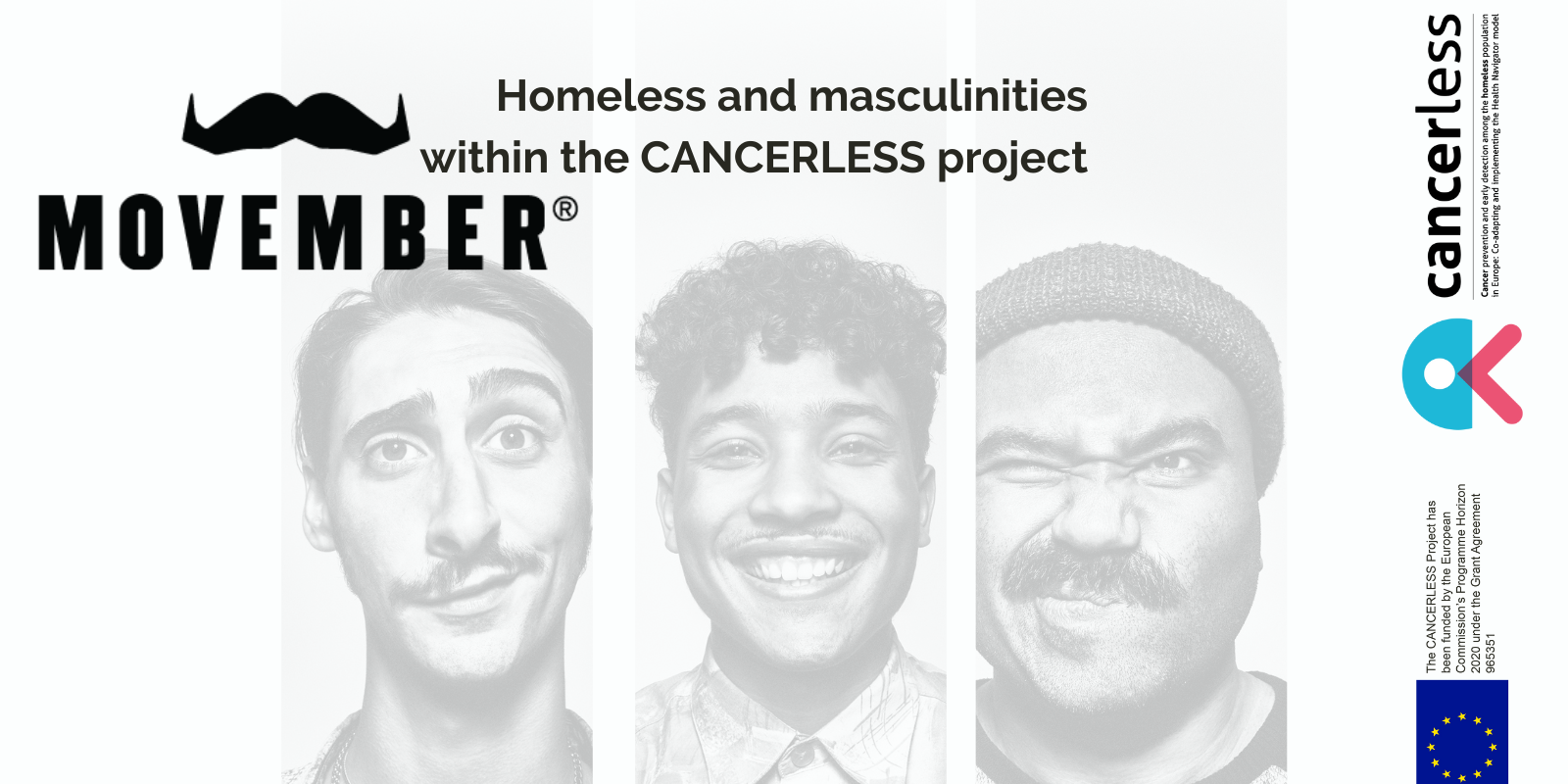Movember is an international initiative for funding projects focused on masculinity, mental health, suicide prevention, prostate cancer, and testicular cancer. Up to date, 1,250 have been funded.
Prostate cancer screening is significantly lower among homeless males whilst high-risk behaviours are higher than the general population (Williams et al., 2018). Social inequalities and health-related disparities in terms of access to health care and involvement-engagement process are critical in co-determining the lower rates of screening, the risk behaviours and the cancer burden faced by the males in a homelessness situation. Still, masculinities and gender norms need to be analysed when analysing the impact and barriers to the prevention and early treatment of testicular and prostate cancer.
Traditional masculinity and homelessness in testicular and prostate cancers
Traditional notions of ‘masculinity’ – at the same time, heterogeneous and culturally-defined – and the consequences in sexual functioning are involved in the patients’ engagement in testicular or prostate care. Sexuality, gender, and taboos are barriers to screening and, specifically, digital recta examinations or active surveillance of testicular cancer, led by the patient (Muermann & Wassersug, 2021). The lack of adapted information, culturally-tailored care, and accessible and affordable prevention and cancer care services are additional barriers for homeless males. They need to overcome the scarcity and deprivation circumstances, the social marginalisation and, at the same time, the meaning – and the embodiment – that prostate and testicular cancers entail regarding normative sexual functioning, self-esteem and identity.
Traditional masculinity implies, among other facilitators and barriers to health engagement, an underutilisation of healthcare resources, hesitant attitudes towards practitioners and reluctance to ask for help (limited inter-personal affectionate and emotional communication and fear of being perceived as weak). Men can be unaware of what it is entailed by PSA tests ad digital rectal examination, the prostate screening process, or the nature of bening versus aggressive cancers (Kannan et al., 2019). Moreover, health-seeking can seem weak and unmanly. The culturally and self-impossed silent stoicism and resistance to seeking help are major barriers to promoting health behaviours (J. N. Drummond et al., 2001). Cultural construct also led to avoid the counselling or consultation with health practitioners unless experiencing severe symptoms (Kannan et al., 2019)
The gendering of space – and the urban space – reflects, determines and has also an effect back in which gender is constructed and understood: urban spaces are gendered places, involving gendered negotiations, territoriality, classification struggles (the homeless and the others), and a survival and self-affirmation territory at the same time(Kennelly, 2020). The quotidian struggles, the minimal social life, how homeless males are also limited within the social field, and the high risk and emergency state that homeless persons apprehend every day allow little room for cancer prevention.
In addition, cultural-specific factors are involved (Chan & Corvin, 2016; Kannan et al., 2019; Rivas et al., 2016): many males in a situation of homelessness are migrants, and cultural constructs of masculinity are heterogeneous and, often, in conflict with the ‘hosting’ country’s culture. It supposes a significant obstacle and challenge for males and healthcare professionals, worsening the difficulties of embracing seeking or asking for help.
Practical considerations for promoting screening among males in situations of homelessness:
The group of peers is a critical recruiter and “health promoter” for males, particularly for those in a situation of special marginalisation. Research shows that males are “more likely to consider being tested if they knew of a friend, relative or celebrity who had done so” (Kannan et al., 2019). However, the most significant obstacles are the socio-economic constraints and the stigma, marginalisation and material deprivation. Barriers to healthcare access and the lack of availability of healthcare must be considered first by making accessible and comprehensive screening campaigns, assisting directly to homeless communities and addressing the very particular concerns raised by this population.
References and addittional literature
Chan, I., & Corvin, J. A. (2016). Chronic Disease and Depression Among Hispanic Americans: Reconceptualising the Masculine Self. American Journal of Men’s Health, 10(6), NP21. https://doi.org/10.1177/1557988315595858
- N. Drummond, M., A. Laws, T., & Poljak-Fligic, J. (2001). Knowledge of and Attitudes towards Prostate Cancer among Italo-Australian Men. Australian Journal of Primary Health, 7(3), 9. https://doi.org/10.1071/PY01040
Kannan, A., Kirkman, M., Ruseckaite, R., & Evans, S. M. (2019). Prostate care and prostate cancer from the perspectives of undiagnosed men: A systematic review of qualitative research. BMJ Open, 9(1), e022842. https://doi.org/10.1136/bmjopen-2018-022842
Kennelly, J. (2020). Urban masculinity, contested spaces, and classed subcultures: Young homeless men navigating downtown Ottawa, Canada. Gender, Place & Culture, 27(2), 281-300. https://doi.org/10.1080/0966369X.2019.1650724
Muermann, M. M., & Wassersug, R. J. (2021). Prostate Cancer From a Sex and Gender Perspective: A Review. Sexual Medicine Reviews, S205005212100010X. https://doi.org/10.1016/j.sxmr.2021.03.001
Rivas, C., Matheson, L., Nayoan, J., Glaser, A., Gavin, A., Wright, P., Wagland, R., & Watson, E. (2016). Ethnicity and the prostate cancer experience: A qualitative metasynthesis. Psycho‐Oncology, 25(10), 1147-1156. https://doi.org/10.1002/pon.4222
Williams, L. B., McCall, A., Looney, S. W., Joshua, T., & Tingen, M. S. (2018). Demographic, psychosocial, and behavioral associations with cancer screening among a homeless population. Public Health Nursing, 35(4), 281-290. https://doi.org/10.1111/phn.12391

